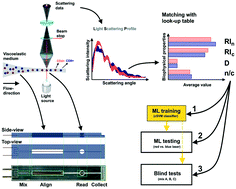CD4+ versus CD8+ T-lymphocyte identification in an integrated microfluidic chip using light scattering and machine learning†
Abstract
T lymphocytes are a group of cells representing the main effectors of human adaptive immunity. Characterization of the most representative T-lymphocyte subclasses, CD4+ and CD8+, is challenging, but has a significant impact on clinical decisions. Up to now, T lymphocytes have been identified by quite complex cytometric assays, which are based on antibody labeling. However, a label-free approach based on pure biophysical evaluation at a single-cell level could enable the ability to distinguish between these subclasses. Here, we report a light-scattering approach, supported by accurate data mining, to evaluate cell biophysical properties on an integrated microfluidic chip. In order to perform single-cell optical analysis in viscoelastic fluids, such a chip is composed of mixing, alignment, readout and collection sections. In particular, we measured the cell dimensions, the refractive index of the cell nucleus, the refractive index of the cytosol, and the nucleus-to-cytosol ratio. Combining measurement of biophysical properties and machine learning allows us to both distinguish and count human CD4+ and CD8+ cells with an accuracy of 79%. An enhanced identification accuracy of 88% can be achieved by stimulating the cells with a selective anti-apoptotic protein, which results in increased biophysical differences between CD4+ and CD8+ cells. This approach has been successfully validated by analysis of samples that recapitulate physiological and pathological scenarios (CD4+/CD8+ ratios). The results are encouraging for the possible application of our approach in hematological clinical routines, as well as in diagnosis and follow-up of specific pathologies, such as human immunodeficiency virus (HIV) progression.



 Please wait while we load your content...
Please wait while we load your content...